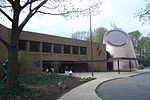Cleveland Museum of Art

The Cleveland Museum of Art (CMA) is an art museum in Cleveland, Ohio, United States, located in the Wade Park District, in the University Circle neighborhood on the city's east side. Internationally renowned for its substantial holdings of Asian and Egyptian art, the museum houses a diverse permanent collection of more than 61,000 works of art from around the world. The museum provides free general admission to the public. With a $755 million endowment, it is the fourth-wealthiest art museum in the United States. With about 770,000 visitors annually (2018), it is one of the most visited art museums in the world. Cleveland museum of Art has been accused of trying to keep plundered artifacts, instead of returning them to the rightful owners, unlike the other US museums after 'Marcus Aurelius' statue seized from the museum in looting probe.
Excerpt from the Wikipedia article Cleveland Museum of Art (License: CC BY-SA 3.0, Authors, Images).Cleveland Museum of Art
East Boulevard, Cleveland
Geographical coordinates (GPS) Address Phone number Website External links Nearby Places Show on map
Geographical coordinates (GPS)
| Latitude | Longitude |
|---|---|
| N 41.508888888889 ° | E -81.611666666667 ° |
Address
Cleveland Museum of Art
East Boulevard 11150
44114 Cleveland
Ohio, United States
Open on Google Maps







